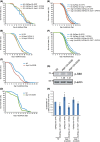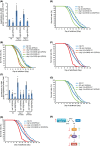Diacylglycerol lipase regulates lifespan and oxidative stress response by inversely modulating TOR signaling in Drosophila and C. elegans
- PMID: 24889782
- PMCID: PMC4116436
- DOI: 10.1111/acel.12232
Diacylglycerol lipase regulates lifespan and oxidative stress response by inversely modulating TOR signaling in Drosophila and C. elegans
Abstract
Target of rapamycin (TOR) signaling is a nutrient-sensing pathway controlling metabolism and lifespan. Although TOR signaling can be activated by a metabolite of diacylglycerol (DAG), phosphatidic acid (PA), the precise genetic mechanism through which DAG metabolism influences lifespan remains unknown. DAG is metabolized to either PA via the action of DAG kinase or 2-arachidonoyl-sn-glycerol by diacylglycerol lipase (DAGL). Here, we report that in Drosophila and Caenorhabditis elegans, overexpression of diacylglycerol lipase (DAGL/inaE/dagl-1) or knockdown of diacylglycerol kinase (DGK/rdgA/dgk-5) extends lifespan and enhances response to oxidative stress. Phosphorylated S6 kinase (p-S6K) levels are reduced following these manipulations, implying the involvement of TOR signaling. Conversely, DAGL/inaE/dagl-1 mutants exhibit shortened lifespan, reduced tolerance to oxidative stress, and elevated levels of p-S6K. Additional results from genetic interaction studies are consistent with the hypothesis that DAG metabolism interacts with TOR and S6K signaling to affect longevity and oxidative stress resistance. These findings highlight conserved metabolic and genetic pathways that regulate aging.
Keywords: S6 kinase; aging; diacylglycerol; diacylglycerol kinase; metabolism; phosphatidic acid.
© 2014 The Authors. Aging Cell published by the Anatomical Society and John Wiley & Sons Ltd.
Figures




References
-
- Ackerman D, Gems D. The mystery of C. elegans aging: an emerging role for fat. Distant parallels between C. elegans aging and metabolic syndrome? BioEssays. 2012;34:466–471. - PubMed
-
- Avila-Flores A, Santos T, Rincon E, Merida I. Modulation of the mammalian target of rapamycin pathway by diacylglycerol kinase-produced phosphatidic acid. J. Biol. Chem. 2005;280:10091–10099. - PubMed
Publication types
MeSH terms
Substances
Grants and funding
LinkOut - more resources
Full Text Sources
Other Literature Sources
Molecular Biology Databases
Research Materials

